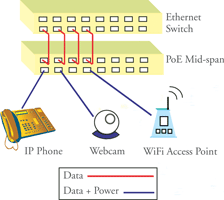
In September 2003, the IEEE published the IEEE 802.3AF standard that defines the specifications to deliver power over standard Ethernet cables.
The Power over Ethernet (PoE) standard has facilitated the global development of technology that allows IP telephones, wireless LAN access points, webcams, credit card scanners and any other appliances to receive power as well as data over existing LAN cabling without needing to modify the existing Ethernet infrastructure.
Such devices in remote locations may be powered and managed with PoE, eliminating the expense of supplying them with 110/220V a.c. power.
The PoE architecture
The PoE specification standard defines the voltage and current requirements of powered Ethernet equipment delivering up to 48 Volts of DC power to PoE-compliant devices over eight-wire Category 5 and 6 cabling. There are two types of architecture. One is called mid-span (See Figure 1), which involves running power over unused wire pairs in a LAN cable.

Mid-span products are built into patch panel-like devices that can add PoE to existing LAN infrastructures. In these installations, the mid-span hub is the power sourcing equipment, while the IP phones, webcams and WiFi access points are the powered devices.
The other increasingly popular version of 802.3AF is called end-span. It runs DC power signals over the same wire pairs used for data transmission. Industry experts say end-span devices are becoming popular because they are usually built into new switches with PoE, which users buy for IP telephony or WLAN rollouts.
Electrical requirements
The addition of power into a LAN results in the requirement for a power management circuit between the power source and the output of the powered Ethernet devices. To this end, Bourns provides designers with a solid state Multifuse resettable PPTC to back up the power management circuit. The PPTC will deactivate any port that is not protected by the power management circuit due to a temporary or permanent fault and thereby prevent any further system failures.
An over-current condition is detected when the current drawn from the power sourcing equipment (PSE) at the power interface (PI) is greater than the overload current limit for any duration greater than the overload time limit.
Multifuse MF-SMDF050
The Multifuse Model MF-SMDF050 is an ideal current limiting PPTC resettable fuse for PoE applications. With a maximum operating voltage of 57 V, it is suitable for the full voltage range of the PoE circuit, 44 V to 57 V. It has an operating current of 500 mA at room temperature and 360 mA at 70°C, which is an excellent fit for the 350mA output current as specified in IEEE 802.3AF.
Being a resettable PPTC fuse, the MF-SMDF050 has an obvious benefit of being resettable which is useful in the area of port protection. The fact that a PPTC resets itself automatically once the fault clears, substantially reduces the need for costly service calls for service technicians.
© Technews Publishing (Pty) Ltd | All Rights Reserved